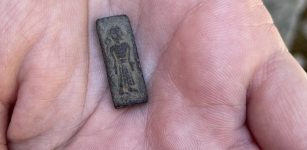New, Unique Wall Paintings Discovered In Old Dongola, Sudan
Conny Waters - AncientPages.com - Archaeologists Dr. Lorenzo de Lellis and Dr. Maciej Wyżgoł unexpectedly stumbled upon an enigmatic complex of rooms made of sun-dried brick, the interiors of which were covered with figural scenes unique for Christian art.
The discovery was made during the exploration of houses dating from the Funj period (16th-19th centuries CE).
Image Credit : Adrian Chlebowski - University of Warsaw
To the surprise of the researchers, beneath the floor of one of the houses was an opening leading to a small chamber, the walls of which were decorated with unique representations.
The paintings within it showed the Mother of God, Christ, as well as a scene depicting a Nubian king, Christ, and Archangel Michael. However, this was not a typical representation of a Nubian ruler under the protection of saints or archangels.
The king bows to Christ, who is seated in the clouds, and kisses his hand. The ruler is supported by Archangel Michael, whose spread wings shield both the king and Christ himself.
Such a scene finds no parallels in Nubian painting. The dynamism and intimacy of the representation contrasts with the hieratic nature of the figures shown on the side walls. Neither does the figure of the Virgin Mary on the north wall of the chamber belong to the typical repertoire of depictions of Mary in Nubian art.
Presentation of Mother of God. Image credit: Magdalena Skarzynska
The Mother of God, shown in a dignified pose, is dressed in dark robes. In her hands she holds a cross and a book. Christ is depicted on the opposite wall. His right hand is shown in a gesture of blessing, and in His left he holds a book, which is fragmentarily preserved.
The paintings are accompanied by inscriptions currently studied by Dr. Agata Deptuła from PCMA UW. A preliminary reading of the Greek inscriptions has led to their identification as texts of the Liturgy of the Presanctified Gifts. An inscription in Old Nubian that accompanies the main scene is extremely difficult to decipher.
Thanks to a preliminary reading by Dr. Vincent van Gerven Oei, the researchers learned that it contains several mentions of a king named David and a plea to God for protection of the city.
The city mentioned in the inscription is probably Dongola, and King David is likely the royal figure depicted in the scene. David was one of the last rulers of Christian Makuria, and his reign marked the beginning of the end of the kingdom.
See also:
Hieroglyphs Discovered In Sudan’s Old Dongola – Once Important City Of Nubia
900-Year-Old Crypt At Old Dongola: Magical Inscriptions And Mysterious Signs Found
Virtual Nubia: Sudan’s Medieval Monasteries Digitally Reconstructed By Polish Archaeologists
For reasons unknown, King David attacked Egypt, which retaliated by invading Nubia and, as a result, Dongola was sacked for the first time in its history. Maybe the painting was created as the Mamluk army was approaching the city or already laying siege to it?
Remains of the Church of the Granite Columns, Old Dongola, Nubia, Sudam. Image credit: Lucio - CC BY 2.
The biggest puzzle, however, is the complex of rooms in which the paintings were found. The spaces themselves, covered with vaults and domes and made of dried brick, are quite small. The room with the painted scene showing king David resembles a crypt, but it is 7 meters above the medieval ground level.
The building is adjacent to a sacral building identified as the Great Church of Jesus, which was probably the cathedral of Dongola and the most important church of the kingdom of Makuria.
Arab sources recounting King David’s attack on Egypt and the capture of the port of Aidhab and Aswan, maintain that this act was instigated by the Great Church of Jesus. Did the Archbishop of Dongola, much like Pope Urban II, incite King David to launch a crusade?
Further excavations may provide answers to these and other questions about the enigmatic structure.
However, the most important objective this season was to preserve the unique wall paintings. Immediately after discovery, conservators under the direction of Magdalena Skarżyńska, MA, set to work.
The conservation team operated as part of a cooperation between the Polish Centre of Mediterranean Archaeology, University of Warsaw, and the Department of Conservation and Restoration of Works of Art of the Academy of Fine Arts in Warsaw. Work in such a confined space, under pressure of time and in high temperatures typical for March in Sudan was extremely demanding.
The paintings were detached from the walls in some places, but the painted layer itself was remarkably well preserved. Conservators secured the wall paintings, made protective bands and putties, and filled the empty spaces between the wall and the plaster with injection fluid.
We may find out whether or not the uncovered structure is a royal commemorative complex, when archaeologists from PCMA UW return to Dongola in autumn.
Written by Conny Waters - AncientPages.com Staff Writer























